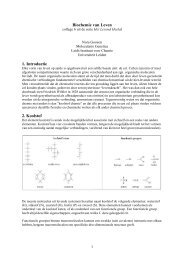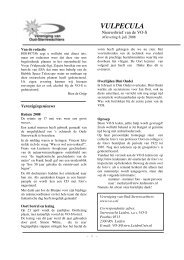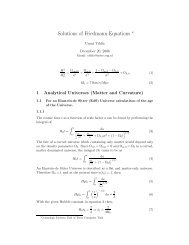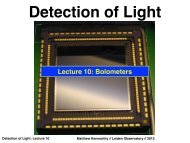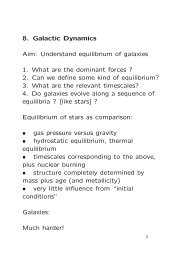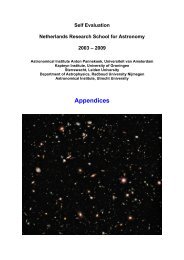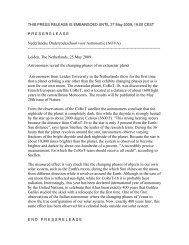4. Structure of Dark Matter halos Obviously, we cannot observe the ...
4. Structure of Dark Matter halos Obviously, we cannot observe the ...
4. Structure of Dark Matter halos Obviously, we cannot observe the ...
Create successful ePaper yourself
Turn your PDF publications into a flip-book with our unique Google optimized e-Paper software.
6-4-10see http://www.strw.leidenuniv.nl/˜ franx/college/galaxies10 10-c04-9<br />
The authors <strong>we</strong>re able to measure <strong>the</strong> velocity dispersion<br />
to 60kpc. This is a record - but still much smaller<br />
than <strong>the</strong> virial radius r200 which is at <strong>the</strong> level <strong>of</strong> 200<br />
kpc.<br />
3. Gravitational deflection <strong>of</strong> light. This method relies<br />
on <strong>the</strong> bending <strong>of</strong> light through gravity. A beautiful<br />
example is when <strong>the</strong> galaxy produces an Einstein ring<br />
<strong>of</strong> a source behind it.<br />
6-4-10see http://www.strw.leidenuniv.nl/˜ franx/college/galaxies10 10-c04-10<br />
In this case, two galaxies are located nearly precisely<br />
behind ano<strong>the</strong>r. The mass inside <strong>the</strong> ring is <strong>we</strong>ll determined.<br />
Ho<strong>we</strong>ver, this method does not extend to<br />
very large radii - one would have to analyze <strong>the</strong> <strong>we</strong>aker<br />
deflections. This is possible, but much harder.<br />
Problems with dark matter <strong>halos</strong> and real<br />
galaxies<br />
Generally, two problems exist: some galaxies may have<br />
ra<strong>the</strong>r large central cores (larger than expected in <strong>the</strong><br />
NFW pr<strong>of</strong>iles), and <strong>the</strong> dark matter <strong>halos</strong> in <strong>the</strong> simulations<br />
have too many “sub-<strong>halos</strong>”.<br />
• Cores<br />
Low surface brightness galaxies have rotation curves<br />
which rise slowly. This is unexpected for galaxies with<br />
NFW <strong>halos</strong>. Naray et al 2007 (arxiv: 0712.0860) show<br />
this result:



